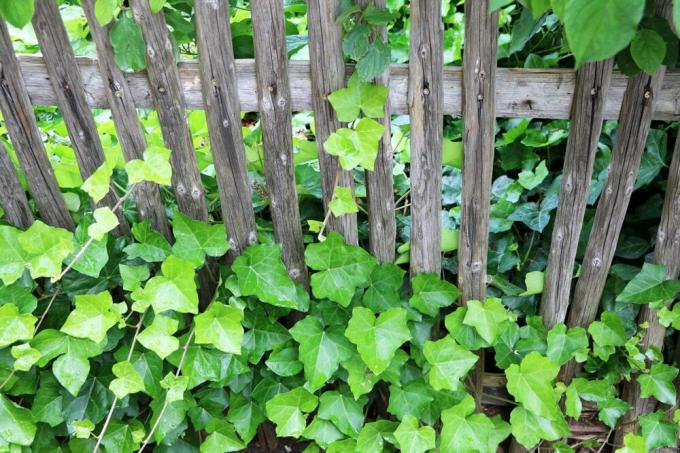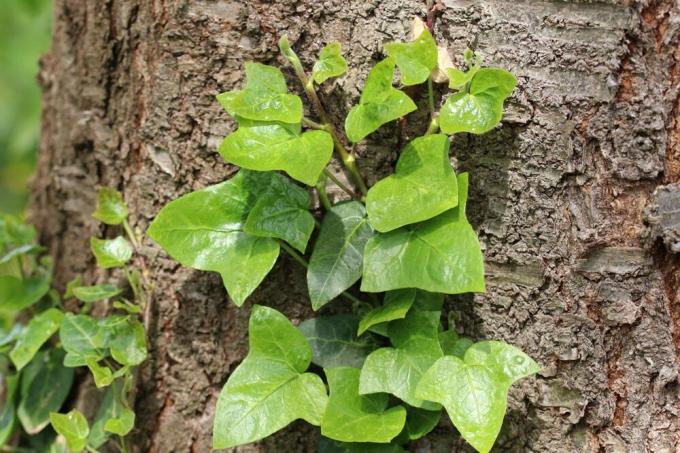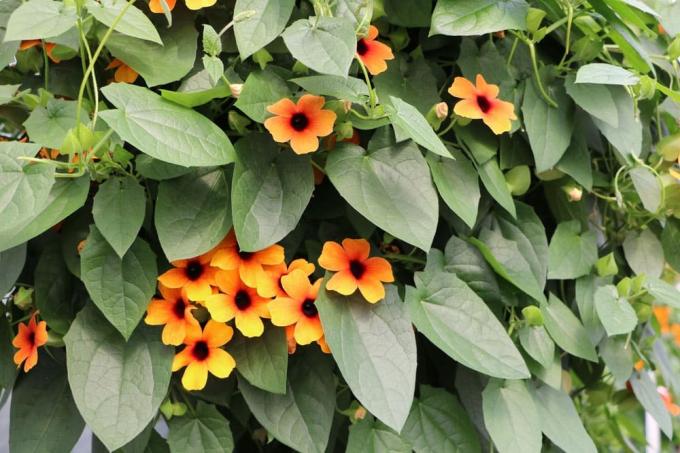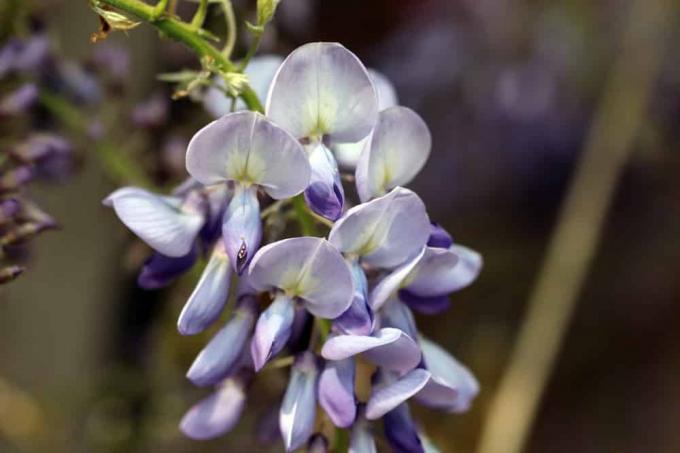

Table of contents
- vigor of ivy
- growth in several stages
- As a young plant
- From the age of about three years
- Age form after ten years
- accelerate growth
- location and soil
- fertilization
- Regular pruning
- Note the toxicity of ivy
This vigorous, evergreen and perennial plant thrives more or less well in different locations and does not require any special care. It is mostly used for greening walls, for hedges or as a privacy screen and ground cover. The leaves of the ivy are particularly decorative. Depending on the variety, they can be deep green or intensively patterned. The growth strength can also vary within the species and varieties.
vigor of ivy
Ivy is well known for its rapid growth and ability to easily attach itself to a wide variety of surfaces. Not only can it climb upwards, it can also spread over large areas on the ground. If it is not properly cared for, especially if it is blended, it can quickly become a massive problem. The vigor of this plant is influenced both positively and negatively by the respective site conditions, fertilization and regular cutting measures. But how fast is it actually growing and can you influence it?
growth in several stages
Depending on the variety and the prevailing conditions, Hedera helix can reach an age of up to 500 years. The maximum growth rate per year can be more than 200 cm under optimal conditions. You should know that the growth of ivy occurs in several stages or stages. stages expires. The first stage, as a young plant, covers the first two years. From the third to the tenth year the plant is in the middle stage. After about ten years, the so-called old-age form is reached. Annual growth varies depending on the stage of growth.
As a young plant
Young plants mean freshly grown plants, for example from cuttings. As a rule, they are planted out in the garden in the spring as soon as they are rooted. In the first year they grow very slowly, usually less than half a meter. The rate of growth was also limited in the two following years. The plants are now investing their energy primarily in the formation of new roots and the first tendrils with adhesive roots.
From the age of about three years

The typically vigorous growth begins around the third year. As the roots develop, the tendrils with adhesive roots become stronger. The ivy keeps growing new shoots and tendrils, with which it grows up facades or crawls over the ground. He tries to escape from the light as much as possible and looks for shady corners. It can gain between five and ten meters in height and width over the next few years, provided it is not cut.
Age form after ten years
After about ten years, when the ivy has reached its old age, it no longer spreads over tendrils, but grows like a bush and only upwards. In contrast, young plants only form tendrils with adhesive roots. From this stage, the meanwhile stately plant looks like a tree, it reduces the growth and thus the growth rate by about half. Nevertheless, it clearly continues to grow and can now be cut into any shape if required.
Tip:
Ivy grown from young shoots forms tendrils and can be grown as a climbing plant. If, on the other hand, it is propagated in its mature form, upright, shrub-like and non-climbing plants develop from the cuttings.
accelerate growth
There are different factors that can accelerate the growth of ivy:
location and soil
- Location and soil have a significant influence on growth rate
- Especially in the first few years
- Ivy grew fastest in optimal conditions
- Pay attention to good site conditions
- Locations with high humidity, plenty of shade and well-drained soil are ideal
- Growth speed here, more than 200 cm per year
- Annual growth lower in places with lots of sun and moist soil
- About 150 cm in a year
- In winter there is a risk of sunburn
- Slowest growth on poor soil, in locations with lots of sun and low humidity
- Is well below 100 cm per year
Tip:
In general, one can say that ivy grows faster the more shady the place and the more constant air and soil moisture.
fertilization
Normally, ivy does not need to be fertilized once it has settled well in a location. However, if the growth of the plants is to be accelerated, fertilization is another possible option.
- Growth acceleration makes sense, especially for young plants
- Especially in the first six weeks after planting
- Now additional fertilizer can additionally stimulate plant growth
- In particular, the supply of nitrogen and potassium
- Horn shavings and compost are good organic fertilizers
- Commercially available liquid or long-term fertilizers are also suitable
- The best time for appropriate fertilizer application is from mid-March to the end of July
- Apply organic fertilizers such as compost and horn shavings in the spring
- Distribute between the individual tendrils as much as possible
Regular pruning

The main purpose of pruning Hedera helix is to curb growth or trim the plant into shape. But after a cut, it also drives back up again particularly quickly. In the first few years, you should still be cautious or be cut minimally. Only after about three to four years does it noticeably increase in growth and begin to proliferate uncontrollably. Then it's time for simple pruning measures. The best time for this is around July/August. This is the time when possible gaps are best seen. The older the ivy is, the faster it grows. This means that you, especially older specimens, cut back again in spring or autumn. Even radical cuts are no problem.
Tip:
The clippings should be completely collected from the ground and, if possible, not disposed of in the compost. Otherwise, the cut shoots can easily regain a foothold and spread elsewhere.
Note the toxicity of ivy
Ivy (Hedera helix) is a poisonous plant. This is due to the toxic substances falcarinol and triterpene aponin contained in all parts of the plant. Skin contact can cause rashes and allergies in sensitive individuals. The consumption of the leaves and especially the fruit can be safe for both children and pets such as pets. B. lead to symptoms of poisoning in cats. The highly poisonous berries form the plants only in old age. They ripen in the spring and should not get into the hands of children.
 Home editorial office
Home editorial office
Learn more about climbing plants

Is black-eyed Susan poisonous?
Black-eyed Susanne can delight all of our eyes with colorful flowers. But if small children or pets are around it, it is important that we also clarify whether it is possibly poisonous. The answer to that is clear and a little surprising!

Black-eyed Susanne, Thunbergia alata: Care from A – Z
Black-eyed Susanne is one of the most popular climbing plants. It is ideal for greening house walls, balconies, fences and pavilions. If you follow our care tips, you will enjoy the splendor of their flowers.

How fast does wisteria grow? | Information about growth
As its name suggests, the wisteria, as an intensive climber, enriches walls, trellis structures and other possibilities for spreading a magnificent, glowing blue sea of flowers. You can find out what you should consider when growing with us in a simple and understandable way.

How fast does Virginia creeper grow? | Information about growth
If you want a trellis or a house wall to be lushly greened, you will find a grateful partner in Virginia creeper. Over time, it can grow into large areas and, especially in autumn, enrich it with colorful foliage. Contact us for helpful information on growth.

Evergreen honeysuckle: care from A to Z
The evergreen honeysuckle is popular for greening walls or fences, because the creeper is green all year round and has beautiful delicate flowers. Although the honeysuckle is not very sensitive, it needs a minimum of care for it to develop well.

When does blue rain bloom? | Beginning and duration of the flowering period
When and how long the wisteria blooms depends on the species and variety. There are both early and late flowering wisteria, so the trees transform the garden into a magnificent and colorful sea of flowers.
